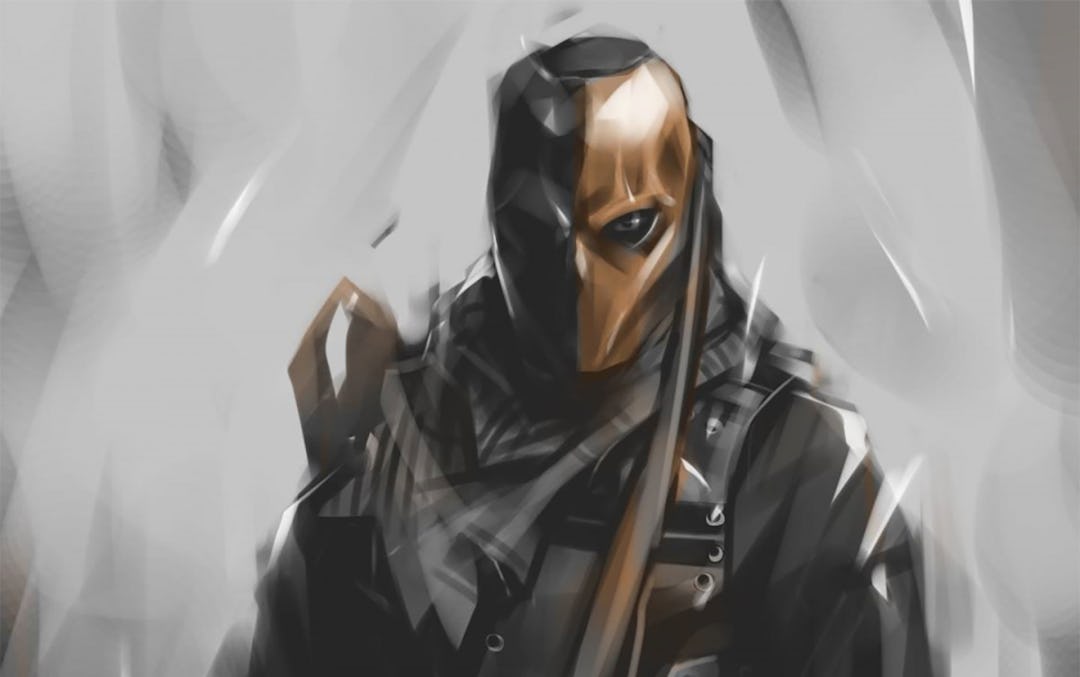My role as Deathstroke in the Nightwing series began when I was teaching my final boot camp class at the Camp Rhino Gym in Las Vegas, Nevada.
I was going about my usual routine, teaching proper form, technique, and pushing everyone to their physical limit, when my friend and colleague Aaron Ortega popped in for a chat.
I was aware that Aaron had performed some stunt work for the lead actor playing Nightwing. Aaron brought up the YouTube series, then asked a question which would forever change my life, “Do you want to play as Deathstroke?” Without hesitation I said, “HELL YES.”
I had no idea what the production budget was or the value of the project, but I had been a huge fan of Deathstroke ever since my youth. It has been a dream come true to bring the character to life.
Aaron Ortega and Adam Zielinski, the directors of the series, suggested me for the part.
I had worked with Adam Zielinski on other projects in smaller roles as a stunt performer through the Arhat Orphan Brotherhood, a Las Vegas Stunt Team created by my friend Aaron Ortega, along with his brother and friend Ezechiel Ortega.
Both Adam and Aaron were aware of my abilities and had the utmost confidence in my ability to handle the role of Deathstroke.
Preparation
Whether it is a Hollywood film or web series, a lot of hard work goes into bringing a vision to life. The big challenge of this project was maintaining my training, my full-time job, and teaching others all while filming the series.
There were a lot of late nights preparing the choreography for each scene; anywhere from 2 to 3 hours a night. Then, once production began, we would film at night anywhere from 10-13 hours each after my regular 9 to 5.
So, how did I survive? I have always been prepared for anything that life throws my way. Constantly factoring in strength training, conditioning, diet, and recovery throughout the day is my definition of “preparation.”
Strength
Proper strength is important for any stunt performer and should be taken seriously, but how do you strength train while working a 40 hour work week and also training others during your free time?
You do it at work during your breaks. Interval strength training while using the best tool available, your own bodyweight, is key.
Your bodyweight is the most accessible tool you have (I don’t think the bosses would appreciate me using a kettlebell around the office).
You must perform strength interval training throughout the day, as often as you can using bodyweight exercises practiced in a slow twitch or fast twitch fashion (personally, I like to change it up each time).
One session could be max reps of push ups, then the next set may be controlled pistol squats for no more than five reps. The idea is to accumulate as many sets as possible throughout the day and change it up to keep things from getting stale.
Conditioning
 Conditioning for stunt performances on film has many outlets, but should be a lifelong practice to get the full benefit. Conditioning is secondary until strength is achieved at all levels.
Conditioning for stunt performances on film has many outlets, but should be a lifelong practice to get the full benefit. Conditioning is secondary until strength is achieved at all levels.
Strength in the body protects the joints and your overall skeletal structure. You don’t want to fall apart, do you?
My conditioning methods come from the philosophy of sprinters. When sprinting, your energy spent is anaerobic rather than aerobic.
Aerobic capacity is tested during long periods of continual activity, whereas anaerobic capacity is utilized during short, intense bursts of activity.
Martial Art stunts are performed in anaerobic short bursts, do to the start-stop nature of filming a scene; directors will quickly cut and change angles for each sequence.
When performing a long continuous shot, it will still be no more than three minutes long.
Even so, you should still train in both anaerobic and aerobic capacities, keeping yourself prepared for anything life may throw your way.
Training methods such as circuits, tabatas, intervals, and ladders are great training choices for this goal. You can mix these up in your program design or just stay choose one.
Duration management is key here; if possible, do your best to keep it continual but exceed no more than 5-20 minutes.
Even the best athletes in a training session put themselves at a risk of injury if they push too hard for too long. Listen to your body!
In my opinion, the best tool for conditioning is bodyweight, but there are other external loading tools that can be used.
My martial arts practice is called Northern Shaolin; we use many different weapons as tools, so this works best for me.
Kung Fu weapons are high skill implements that take years of practice to master, so keep this in mind.
The best simulation of martial arts weapons are tools like steel maces, indian clubs, kettlebells, and battle ropes (which incidentally make Onnit the king of simulating ancient combat warfare).
Agility
I like to look at agility as a byproduct of everything: strength, skill, conditioning, speed, flexibility, plyometrics, etc. Agility is usually demonstrated with jumps, rolls, kicks, punches, falls, and general mobility. You must master these traits if you are considering stunt work as a career.
You may be asked to adapt to a change in the script at the drop of a hat, so preparation is key in this scenario. An example of this was the suit I was required to wear for the role of Deathstroke.
It was extremely cumbersome, the mask created tunnel vision, and the overall equipment, pads, and holsters affected my movement. You must work on your agility if you plan to survive!
Diet & Recovery
Now for the diet, everyone’s favorite part! I would be a liar if I told you I watched my diet every single day, but when you’re on set performing extremely physical scenes it’s important to consider it.
Food is fuel you’ll need it to keep running smoothly both mentally and physically. You need to be mindful of the foods that will give you energy, not the ones that will bloat or over stuff you.
The opening scene of the first episode was definitely my greatest challenge. I had just gotten back from a trip to Japan and had exactly one week to prepare the choreography for the scene.
Jet lag had set in the night before and I only got one hour of sleep. I then went to work and snuck in an hour nap after my shift. After work, I had to be on set to prepare my costume and choreography.
We started filming at 8:00 p.m. that night and I was on call the entire night (no naps for me!). We finished at 5:30 a.m. and wrapped by 6:00 a.m. I was back at work at 8:00 a.m. so it was quite the day.
If I hadn’t been watching what I consumed the days prior, I never would have made it through that night on set. Remain conscience of what you eat and moderate if you plan to endure unseen events.
The long hours on set, combined with the high risk stunts that can occur, makes recovery a must for any stunt performer. You should be performing mobility movements and static stretches daily, but they are especially critical during shoot days.
Injuries are bound to happen when taking falls and performing fight choreography; I was hit countless times, more than I could keep track of.
Following the P.R.I.C.E. (Protect, Rest, Ice, Compression, Elevation) Method even if I didn’t actually feel any pain or swelling kept me in action. Just because you can’t feel it or see it, does not mean damage is not happening.
Out of sight, out of mind is not the best practice when your recovery is at hand.
Credits
There were three actors involved in creating Deathstroke for the Nightwing series. Bob Dysinger the face actor, Michael Tylo the voice actor, and myself who performed the stunts and body acting. I look at it this way: I was the Darth Vader of Nightwing the series.
I cannot take all the credit and am extremely fortunate being involved on this project with such talented gentlemen. To be able to represent my martial arts teacher Sigung Steven Baugh, and of course Onnit as a contributor and now trainer.
So if you’re a fan of the DC Comic Universe, checkout the YouTube channel ISMAHAWK and catch Deathstroke in action.
Thanks again to Danny Shepherd and Jeremy Le for creating the Nightwing series; this has been a wonderful and memorable experience.
Thanks also to my team leader Aaron Ortega of the Arhat Orphan Brotherhood stunt group, along with the director Adam Zielinski for suggesting me for the role of Deathstroke and having the confidence in me in the first place.
I was at the very first ONNIT Academy Trainer Certification course late last September, and was asked if I could write an article about my experience portraying Deathstroke. I would like to thank all of the Onnit staff members for being as excited as I was about the experience.




)





